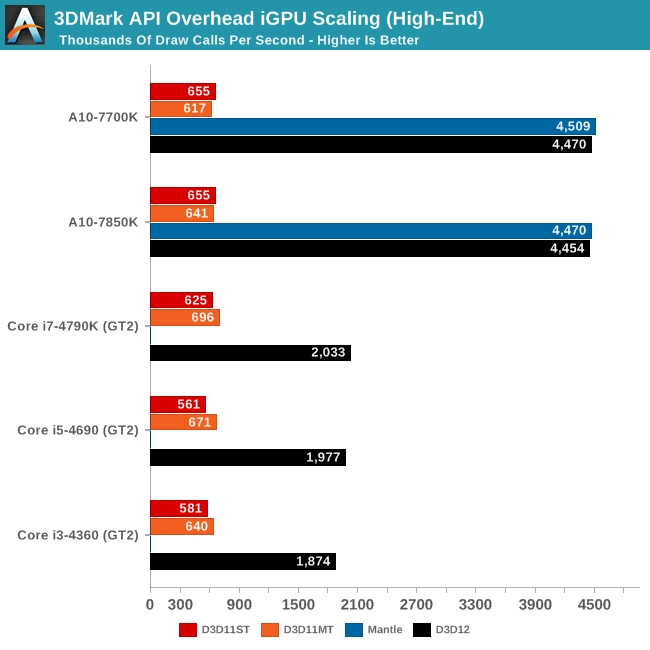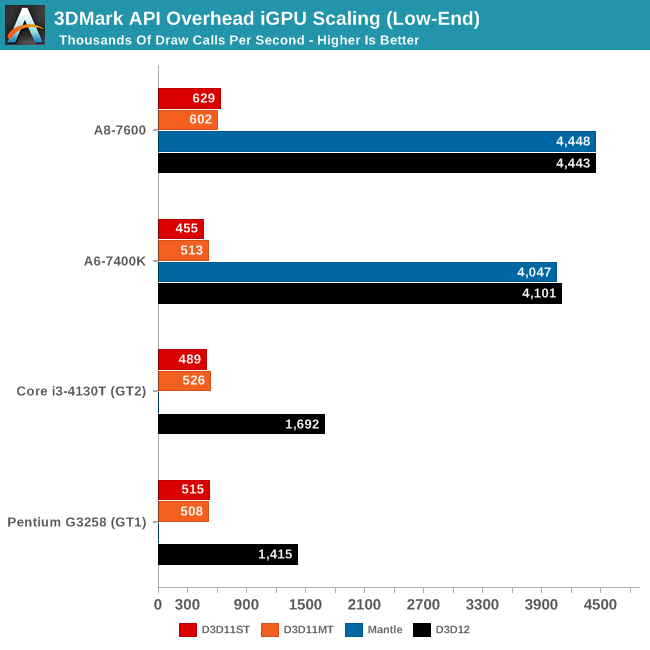Exploring DirectX 12: 3DMark API Overhead Feature Test
by Ryan Smith & Ian Cutress on March 27, 2015 8:00 AM EST- Posted in
- GPUs
- Radeon
- Futuremark
- GeForce
- 3DMark
- DirectX 12
Integrated GPU Testing
Switching gears from high performance discrete GPUs, we have our integrated GPUs. From a high level overview the gains from DirectX 12 are not going to be quite as large here as they are with dGPUs due to the much lower GPU performance, but there is still ample opportunity benefit from increased draw call performance.
Here we have Intel’s Haswell CPUs, and AMD’s Kaveri APUs. We'll start off with the higher-end processors, the Intel Core i3/i5i7 and AMD A10/A8.

As expected, at the high-end the performance gains from DirectX 12 are not quite as great as they were with the dGPUs, but we’re still seeing significant gains. The largest gains of course are found with the AMD processors, thanks to their much stronger iGPUs. From DX11ST to DX12 we’re seeing a surprisingly large 6.8x increase in draw call performance, from 655K to 4,470K.
As to be expected, with a relatively weak CPU, AMD’s DX11 draw call performance isn’t very strong here relative to their strong GPU and of course our more powerful dGPUs. Still, it ends up being better than Intel (who otherwise has the stronger CPU), so we see AMD offering better draw call throughput at all levels. Ultimately what this amounts to is that AMD has quite a bit more potential under DX12.
Mantle meanwhile delivers a very slight edge over DX12 here, although for all practical purposes the two should be considered tied.
Meanwhile for the Intel CPUs, the gains from DX12 aren’t quite as large as with the AMD processors, but they’re still significant, and this is why Intel is happily backing DX12. All 3 processors share the same GT2 GPU and see similar gains. Starting from a baseline of 625K draw calls under DX11 – almost identical to AMD – the i7-4790K jumps up by 3.2x to 2,033K draw calls under DX12. The i5 and the i3 processors see 1,977K and 1,874K respectively, and after adjusting for clockspeeds it’s clear that we’re GPU command processor limited at all times here, hence why even a 2 core i3 can deliver similar gains.
Intel does end up seeing the smallest gains here, but again even in this sort of worst case scenario of a powerful CPU paired with a weak CPU, DX12 still improved draw call performance by over 3.2x. This means that in the long run even games that are targeting lower-performance PCs still stand to see a major increase in the number of draw calls they can use thanks to DirectX 12.

The story is much the same with our lower performance processors. AMD continues to see the largest gains and largest absolute performance under DirectX 12. With a 7x performance increase for the A8, even this weaker processor benefits greatly from the use of a low-level API.
The Intel processors see smaller gains as well, but they too are similarly significant. Even the Pentium with its basic GT1 processor and pair of relatively low clocked CPU sees a 2.7x increase in draw call performance from DirectX 12.










113 Comments
View All Comments
Laststop311 - Saturday, March 28, 2015 - link
The benefit will come mainly for people using chips with many cores but poorer single threaded performance. That's basically quad core AMD APU users and 8 core FX chip and 6 core phenom II x6. Since users of those cpu's are the people most likely to be CPU bottlenecked due to dx11 only caring about single thread performance. Since intel chips have top tier single threaded performance they were not as restricted in dx11 and the gpu was usually the bottleneck to begin with so not much change there the gpu will still be shader bound.silverblue - Saturday, March 28, 2015 - link
I'm glad somebody mentioned the Phenom II X6. I'd be very interested to see how it copes, particularly against the 8350 and 6350.akamateau - Thursday, April 30, 2015 - link
AMD A6 APU has 4.4 million draw calls per second running DX12. Intel i7 4560 and GTX980 only has 2.2MILLION draw calls running DX11!!!!DX12 allows a $100 AMD APU by itself to outperform a $1500 Intel/nVidia gaming system running DX11.
That is with 4 CORES. Single core performance is not relevant any more.
All things being equal, DX12 will give AMD APU and Radeon dGPU a staggering performance advantage over Intel/nVidia.
FlushedBubblyJock - Tuesday, March 31, 2015 - link
What's the mystery ? It's Mantle for everyone - that's what DX12 essentially is.So just look at what mantle did.
Close enough.
StevoLincolnite - Friday, March 27, 2015 - link
The consoles are limited to 6 cores for gaming, not 8, those 6 cores are roughly equivalent to a Haswell Core i3 in terms of total performance (Or a high clocked Pentium Anniversary!).Remember, AMD's fastest high-end chips struggles to beat Intel's 4 year old mid-range... Take AMD's low-end low-powered chips and it's a laughable situation.
But that's to be expected, consoles cannot afford to have high-end components, they are cost sensitive low-end devices.
Lets just hope that Microsoft and Sony do not beat this horse for all it's worth and we get a successor out within the next 4ish years.
The Xbox One also uses a modified version of Direct X 11 for it's high level API.
The Xbox One also has a low-level API which developers can target and extract more performance.
Basically once Direct X 12 is finalized for the PC it will be modified and ported to the Xbox One, giving developers who do not buy an already made game-engine like Unreal, CryEngine etc' a performance boost without blowing out development time significantly by being forced to target the low level API.
The same thing is also occurring on the Playstation, the high-level API is getting an overhaul thanks to Vulkan, it still has it's low-level API for developers to target of course.
Ram is still a bit of an issue too, 5-5.5Gb of Ram for the game and graphics is pretty tiny, it may become a real limiter in the coming years, slightly offset with hard drive asset streaming.
To compare it to a PC the Xbox One is like a Core i3 3ghz, 4Gb of Ram, Radeon 7770, 1.5Gb graphics card.
Change the GPU to a Radeon 7850 for the PS4 and that's what we have for the next half decade or more.
Laststop311 - Saturday, March 28, 2015 - link
Correct me if I'm wrong but I believe the ps4 is built with a downclocked 7870 (20 cu) but the ps4 igpu has 2 CU disabled as well as the downclock. The 7850 is a 16 CU part but i guess the 2 extra CU combined with the downclock would make the ps4 behave like a 7850. the radeon 7770 is only 10CU and the xbone has 12CU's but a lower clock. So are you basically saying for the ps4 and xbone the extra 2cu + the lower clock speed makes them equal to those desktop cards? Because they really aren't exactly those cards. Some situations the higher clock speed matters more and some the more cu's matter more. In some situations the ps4 may behave more like a 7870 than a 7850 and the xbone may be more like a 7790 than a 7770 in some situations.Gigaplex - Monday, March 30, 2015 - link
The console CPUs are actually significantly slower than a Haswell i3. The Pentium chips are a closer comparison due to the lack of hyperthreadingmr_tawan - Monday, March 30, 2015 - link
'PC is not meant to be played' (TM)(Just kidding though)
If the developers done their jobs right, hi-specs PC still gains much advantage over console (especially in the frame rate area). However PC itself are also a drag as well (remember those Atom/Pentium equipped PC).
JonnyDough - Tuesday, March 31, 2015 - link
Half the time it's just that they don't even bother updating menus and controls. Skyrim is a prime example.Veritex - Friday, March 27, 2015 - link
All the next generation consoles are based on AMD eight core CPU and GCN architecture (with Nintendo possibly opting for an ARM CPU paired with GCN), so developers will just have to optimize once for the consoles and have a easier time porting to PCs.It is interesting to see the AMD R9-285 Tonga consistently outperform Nvidia's high end GTX 980 and its make you wonder how incredibly fast the next generation R9-390x Fiji and 380x could be.